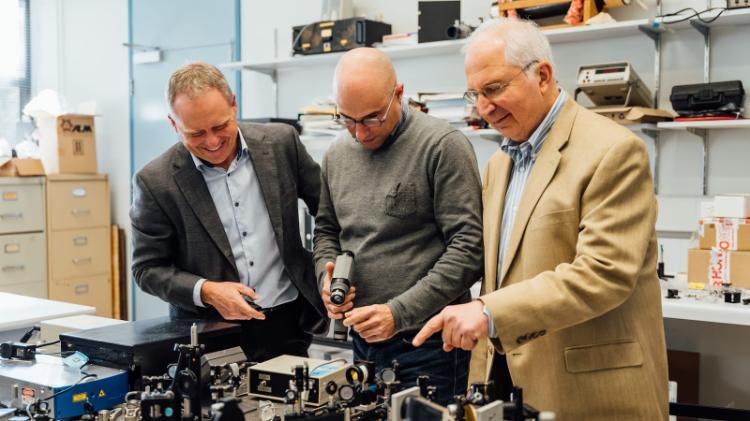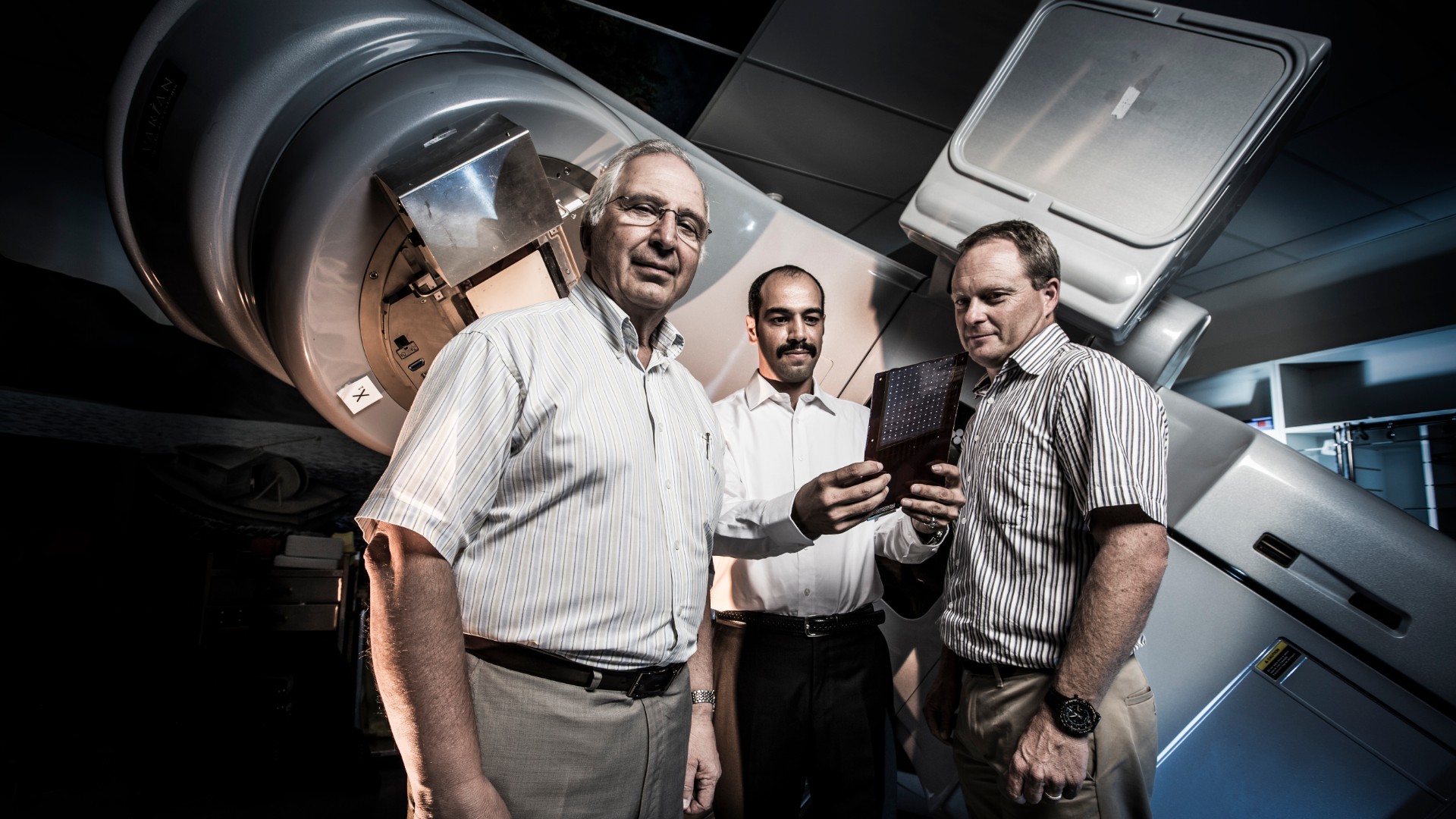Centre for Medical Radiation Physics (CMRP)
Overview
The Centre for Medical Radiation Physics is a research team within the School of Physics, University of Wollongong. We are dedicated towards the development of semiconductor detectors and dosimeters for clinical applications in radiation protection, radiation oncology and nuclear medicine as well as high energy physics applications.
Core objectives
- Excellence in research and development in the field of radiation instrumentation and measurements with particular emphasis on medical and high energy physics applications.
- Excellence in teaching (BSc,MPhil,PhD) medical physicists and engineers for research and clinical careers.
- Active collaboration with local and international institutions to facilitate broader research efforts in new radiation oncology modalities and nuclear medicine applications.
- Directed towards final commercialisation of research and development efforts in Australia.
Centre for Medical Radiation Physics celebrates 25 years of research breakthroughs
World-renowned researchers and clinicians recognised milestone at prestigious conference
Read more about the 25 years of research breakthroughs
Latest News
Clinical Radiation Dosimetry
At the CMRP, our focus is bench-to-bedside research that translates innovative radiation sensors (dosimeters) into improvements in clinical practice, to ensure the quality of modern x-ray radiotherapy. Over the past two decades, we have developed and led to clinical implementation a number of cutting-edge dosimeters based on semiconductors, such as the MOSkin, the Dose Magnifying Glass and the Magic Plate suite (the Magic Plate, the Duo, the Octa), and the BrachyView.
The MOSkin is a unique point-like sensor that has been used to measure, for the first time, radiation dose at a depth of 0.07 mm - in real time!; the MOSkin has applications for in vivo quality assurance, e.g. on the skin of a patient undergoing radiotherapy. The Dose Magnifying Glass and the Magic Plate suite are the first 1D and 2D sensors that can measure radiation dose with a spatial resolution down to 0.2 mm - in real time!; they can be used to commission both a treatment machine (medical linac) and the treatment of a specific patient undergoing radiotherapy. The BrachyView is a sensor used to verify, in real time, the position of the radioactive source in brachytherapy.
Our Australian partners in NSW: Illawarra Cancer Care Centre (Wollongong), St. George Hospital (Kogarah), Prince of Wales Hospital (Randwick), Liverpool Hospital (Liverpool), Royal North Shore Hospital (St. Leonards), Calvary Mater Newcastle (Waratah). Our Australian partners: Peter MacCallum Cancer Centre (Melbourne), Sir Charles Gairdner Hospital (Nedlands), 5D Clinics (Claremont), ANSTO and the Australia Synchrotron. Our International partners: Memorial Sloan Kettering Cancer Center (NY, USA), Montefiore Hospital, Albert Einstein College of Medicine (NY,USA), Massachusetts General Hospital (MA, USA), Mayo Clinic (USA), Istituto Neurologico Besta (Milan, Italy), Alpha Tau Medical (Israel), Istituto Nazionale di Fisica Nucleare (Catania, Italy), National Institute for Radiological Science (Japan).
Microdosimetry
The aim of this project is to investigate and develop a silicon-based microdosimeter which offers the possibility of replacing the current proportional gas counter for measurements of radiation deposited in cellular (10um diameter) sized volumes. Such a device will be more portable, easier to use and cheaper.
A prototype microdosimeter using Silicon-On-Insulator(SOI) technology was built at Fujitsu Research Laboratories Ltd. The device has been tested under clinical conditions in several high LET radiation oncology modalities including Boron Neutron Capture Therapy (BNL, USA and Kyoto, Japan), Fast Neutron Therapy (Harper Hospital, Detroit) and Fast Proton Therapy (KEK, Japan). Several of these devices will be tested in low earth orbit as part of the project, a collaborative project between CMRP, USNA, Johns Hopkins University and Memorial Sloan Kettering Cancer Care Centre.
Nanodosimetry
Nanodosimetry aims to measure the spatial distribution of ionisations within a low-pressure gas model of a DNA segment. This information may be used to predict the radiobiological properties of the radiation field, with applications in proton and charged-particle therapy, radiation protection, and space research. This research is carried out in close collaboration with the Loma Linda Proton Therapy Centre.
Microbeam
Microbeam Radiation Therapy (MRT) is a new kind of radiation treatment for cancer patients which uses a uniplanar array of synchrotron X-ray beams each 30 microns in thickness. CMRP has proposed and tested a new method of dose mapping for single 30-micron beams with a spatial resolution of 1 micron using vertical MOSFET detectors.
Collaborators: European Synchrotron Radiation Facility, Illawarra Cancer Care Centre, St. George Hospital (Australia), BNL(USA), REM OXFORD (UK)
Neutron Dosimetry
We are studying the application of P-I-N silicon neutron dosimeters and MOSFETs for separate dosimetry in mixed gamma-neutron fields and verification of Monte-Carlo calculations in Boron Neutron Capture Therapy (BNCT), fast neutron therapy, Cf-252 brachytherapy, and proton therapy.
Monte Carlo Techniques
Monte Carlo techniques are used extensively in the simulation of experimental measurements. The group is involved with the use of such tools as:
- GEANT4
- MCNP
Geant-4 Research
Geant-4 Research is a Monte Carlo Simulation Toolkit describing the interactions of particles with matter. It is widely used in radiation physics research, from High Energy Physics to medical physics and space science.
Australasian College of Physical and Engineering Sciences in Medicine
Nuclear Instruments and Methods in Physics Research Section A
Applied Radiation and Isotopes
International Journal of Radiation Oncology*Biology*Physics
European Journal of Nuclear Medicine
IEEE Transactions on Medical Imaging
International Journal of Nuclear Medicine and Biology
Physics in Medicine and Biology
Radiation Protection Dosimetry
Australian collaborating institutes
NSW
Australian Nuclear Science and Technology Organisation (ANSTO)
Centre for Oncology Education & Research Translation
Illawarra Cancer Care Centre, Wollongong Hospital, Wollongong
Ingham Institute, Sydney
Liverpool Hospital, Department of Radiation Oncology, Sydney
Prince of Wales Hospital (POWH), Department of Radiation Oncology, Sydney
Royal Prince Alfred Hospital (RPA), Department of PET & Nuclear Medicine, Sydney
St George Cancer Care Centre, St. George Hospital, Kogarah
St Vincent's Private Hospital, Sydney
University of Sydney, Radiation Physics Laboratory
Westmead Hospital, Radiology Department, Sydney
VICTORIA
Australian Institute for High Energy Physics (HEP)
Peter MacCallum Cancer Care Centre
University of Melbourne, School of Physics, Experimental Condensed Matter Physics (ECMP)
University of Melbourne, School of Physics, Experimental Particle Physics (EPP) Group
International collaborating institutes
France
European Synchrotron Radiation Facility (ESRF), Grenoble
Japan
Gunma University Heavy Ion Medical Centre
National Institute of Radiological Sciences
Italy
Politecnico di Ingegneria Nucleare, Politechnico di Milano, Milano
Switzerland
Ukraine
USA
Gershenson Radiation Oncology Center, Harper Hospital and Wayne State University
Loma Linda University, Division of Biomedical Engineering Sciences
Massachusetts General Hospital Cancer Center, Boston
Mayo Clinic, Proton Beam Therapy Program
Memorial Sloan Kettering Cancer Center, NY
Brookhaven National Laboratory, National Synchrotron Light Source 11
